Abstract
This study was carried out throughout two successive seasons 2015 and 2016 at Horticulture Research Station at El-Kanater El-Khayria, Qalyubeia Governorate on 20-year-old avocado trees (Persea americana Mill.) “Fuerte” cultivar grafted on Dayouk rootstock and irrigated with through farrow (surface) irrigation system. In this sequence (N1) as the control or untreated trees and other trees were treated with four treatments of different addition times of nitrogen soil fertilization (N2, N3, N4 and N5) all only once and once with boron and zinc as foliar spraying in concentrations (1, 2 and 3 g/L) beside combination between them. Nitrogen fertilization rated 1200g /tree in 3 times as (NH4No3) 33. 5%. Boron was used as sulaphate boron (17, 5%) and zinc was used as sulphate zinc (34%) each treatment was sprayed independently or in combination three times during (October, January, April). Pollen germination, fruit set as well as yield, fruit weight, flesh weight, oil content percentage and vitamin C were determined to assess the effect of the treatments. The obtained results showed that nitrogen soil application time and boron and zinc foliar spraying were significantly affected on improving all the tested parameters compared with control trees. The study also showed that, nitrogen soil application time N2 with boron and zinc combination at 1g/L/tree was more effective than the other treatments and gave significantly the highest values in comparison of other testes treatments in both seasons of study.
Keywords: Avocado; Fuerte; Nitrogen; Boron; Zinc, Foliar spraying; Application time; Fruit set; Fruit quality and oil content
Introduction
The avocado Persea Americana, Mill belongs to the family Lauraceae. It has developed into three horticultural races (West Indian, Guatemalan and Mexican [1], which are adaptable to a wide range of soil and climatic conditions. Avocado which has been referred to as the most nutritious of all fruits [2], has gained worldwide recognition and significant volume in international trade. Although relatively new in international commerce, this unique fruit has been appreciated and utilized for at least 9000 years in and near its center of origin in Meso-America [3]. Avocado is a relatively new crop in areas of the world outside its native range in the American tropics. In 2013, world production of avocados was 4.7 million tons, with Mexico alone accounting for 32% (1.47 million tons) of the total production. Other major producers include Dominican Republic, Colombia, Peru and Indonesia, together totaling 1.26 million tons or 28% of world production (FAOSTAT of the United Nations 2013). “Fuerte” is one of the most common avocado cultivars in the international market. “Fuerte” accounts for about 55% of the production in Mexico and California and is important in other countries [4] and [5]. In Egypt, the avocado was grown in limited areas in El-Delta, in 50s and 60s of the previous centuries. Only Fuertre and Dayouk were grown in these areas until recent were new areas as El-Nubaria, Ismailia and El-Khatatba started to be grown with avocado.
“Fuerte” the most spread cultivar is a Mexican _ Guatemalan hybrid, Trees are large, with spreading crowns; leaves have aniseed smell when crushed, red flecking on wood of new shoots; flower Group B, fruit pyriform with distinct neck but variable ranging from elongated with long narrow neck to dumpy with short broad neck, medium to large size weighing 170–500 g, skin thin, green, medium gloss, supple leathery texture, pimpled surface, seed size is Medium to large, conical with pointed apex, early maturing with pale yellow flesh, 75–77% recovery, excellent quality with flavoursome, nutty after-taste, good on-tree storage, but short shelf-life when ripe. The chemical composition of avocado depends on the cultivar and stage of ripening [6]. In Egypt, “Fuerte” is harvested all year round but its’ main season is from October to December. Main problems facing avocado plantations are slow to reach production, low yields in cooler climates with a marked tendency for erratic cropping and sensitivity to low temperatures during flowering and fruit set [7].
Nitrogen seems to be the most important element in avocado nutrition. Deficiencies of nitrogen in avocado result in small, pale leaves, early leaf drop, and smaller and fewer fruits [8]. In addition, nitrogen deficient trees were found to be more susceptible to frost damage [9]. Boron is essential for pollen germination, for successful growth of the pollen tube through the stigma, style and ovary to the ovule [10]. On worldwide basis zinc (Zn) is a very critical microelement because the avocado is very susceptible to their deficiency. Symptoms of Zn deficiency are observed in acid soils from which it is easily leached at a low pH and in calcareous soils in which it is fixed in unavailable forms. Early deficiency symptoms are mottled, narrow, disproportionately small leaves at the terminals, usually light green or chlorotic in color. Leaf margins are necrotic, and internodes are shortened in advanced cases [11].
Numerous fertilization regimes were proposed by several scientists to overcome cropping problems [12] studied the effect of nitrogen fertilizer application times and rates on “Hass” avocado to increase total yield without reducing fruit size and found that application time proved to be an important determinant of total yield lower annual N would reduce fertilizer expense and protect the environment. Boron sprays applied either during fall or spring on trees not deficient in boron (based on leaf analyses) have been effective in increasing fruit set in a number of deciduous tree fruit, nut crops and in avocado [13]. [14] on avocado trees proved that B and Zn were significantly improved pollen germination; fruit set number as well as yield per tree and increased fruit weight, length and breadth of fruits. They showed that the combination of B+Zn had positive synergistic effect and gave the highest values in the tested parameters. According to [15] Zn level at (0.5 %) improved fruit set wheras levels (0.25, 0.5 %) were more effective on fruit drop number and enhanced production of piryform fruits with more elongation. The scope of the present study was to illustrate the impact of nitrogen fertilization regimes with or without foliar sprays of both zinc and boron on the performance of Fuerte avocado trees.
Materials and Methods
This investigation was carried out through the two successive seasons of 2015 and 2016 on 20-year-old avocado trees (Persea Americana, Mill.) “Fuerte” cultivar grown in the experimental orchard of the Horticulture Research Station located in El-Qanater El-Khayreia, Qalubia Governorate, Egypt. Trees were planted at 7x7 meters (86 trees/ feddan (. One hundred and fifty Feurte cultivar trees grafted on Dayouk rootstock were chosen for this study. The chosen trees for the investigation were uniform in their vigor, size, shape and disease free, grown on loamy clay soil and irrigated with a farrow (surface) irrigation system. Trees were subjected to normal cultural practices recommended by the Ministry of Agriculture except for the treatments of this investigation. Experimental design followed the complete randomized block design. The following regimes were conducted each on three separate trees (each acting as a replicate).
Considered fertilization regimes
Nitrogen fertilization regimes: All trees used in this investigation were fertilized by broadcast with 1200 gm N as the recommendation of ministry of Agriculture (the fertilizer ammonium sulfate 20% N was used). Five regimes were considered based on percentage and time of application. The considered regimes were:
N1: Control as farm’s regime. Fertilizer was split into 3 doses i.e. November 400 g/tree (33.3%), 400 g/tree (33.3%) in January and 400 g/tree (33.3%) in May.
N2: Fertilizer was split into 3 doses 240g/tree (20%) in (January), 600 g/tree (50%) in (May) and 360 g/tree (30%) in (August).
N3: 600 g/tree (50%) in (January), 360 g/tree (30%) in (May) and 240 g/tree (20%) in (August).
N4: 600 g/tree (50%) in (January) and 600 g/tree (50%) in (May).
N5: 600 g/tree (50%) in (May) and 600 g/ tree (50%) in (August).
Boron and zinc regimes
B: boron the product boron sulphate (17. 5% B) was used in three concentrations (1, 2, 3 g/L) / tree i.e. (175, 350, 525 ppm) respectively as B1, B2 and B3.
Zn: zinc the product zinc sulphate (34.5% Zn) was used in the same concentrations (1, 2, 3 g/L) / tree (345, 690, 1035 ppm) respectively as Zn1, Zn2 and Zn3.
B+Zn: combination between them as (B1+Zn1, B2+Zn2 and B3+Zn3) in (1, 2, 3 g/L) / tree.
Treatments were sprayed with a mechanical sprayer until runoff each for three times, the first at the beginning of flower bud induction in (October), the second spray was at bud burst during (January) and the last and third one was at anthesis in (April). Fifty treatments were performed each on 3 separate trees as follows: N1, N1+B1, N1+B2, N1+B3, N1+Zn1, N1+Zn2, N1+Zn3, N1+B1+ Zn1, N1+B2+ Zn2 and N1+B3+ Zn3 and the same way with the treatments N2, N3, N4 and N5.
The following parameters were assessed to evaluate the comparative effects of the conducted treatments.
a) Pollen grains germination percentage
Five inflorescences were chosen randomly on each of the considered trees to assess comparative effects of conducted treatments on this parameter and the fruiting parameters. Pollen germination (%), Pollen grains were collected during anthesis stage. Flower in the male stage of the reproductive cycle were collected in paper bags then transferred to the laboratory. After anther dehiscence when pollen shed they were collected and incubated in Petri dishes on a medium containing 15% sucrose and 0.8% agar according to [16]. Pollen germination was recorded after 6 hours as the percentage of germinated pollen in a total of 500 grains from different areas of plat. Each pollen sample was replicated three times. Pollen was considered to have germinated if pollen tube length was at least twice as long as the diameters of grain, samples were observed by Optical microscope.
b) Yielding Parameters
In both seasons, fruit set was determined by marking five flowering branch ends around the circumference of each treated trees two weeks after full bloom and fruit set percentage was calculated. On the last week of August just at harvest time the number of fruit/ branches was counted to estimate the final fruit set (number of fruits per branch/number of initial flowers *100). At harvest, fruits of each tree were picked, counted and weighed with a digital balance in Kgs. The yield (Kg) was determined as total number of fruit / tree *Average fruit weight (gm)/1000).
c) Fruit quality Parameters
Mature Fuerte fruits were harvested at the 3rd week of September maturity according to [17]. Samples of five representing fruits from each considered tree are harvested, cleaned packed in carton boxes in one layer and transferred to laboratory then both of physical and chemical parameters were assessed.
i. Physical Parameters
The following parameters were determined: fruit weight (g) and flesh weight (g) by using a digital balance.
ii. Chemical Parameters
Free fatty acids were determined by comparison of retention time of the gas chromatographic peaks with these of commercial free fatty acid methyl ester standards, then automatically computed as a percentage by the data processor (Chrom card) from the ratio of individual peak area to the total peaks area of fatty acids. Vitamin C as mg ascorbic acid/100 gm fruit weight was determined and estimated/ 100 ml fruit juice, according to [18].
d) Statistical design and data analysis
Experimental design followed the complete randomized block design. The obtained data was subjected to factorial analysis according to [19]. Attained means were compared by using New LSD method at 5%.
Results and Discussion
Fruit set parameters
Table 1: Effect of nitrogen soil application time, boron and zinc foliar spraying on pollen germination percentage per tree.

Pollen grains germination (%): Data presented in Table 1 showed that pollen germination percentage significantly varied with adopt treatments. With respect to nitrogen regimes, on the average the highest significant percentage attained was dedicated to (N2) treatment amounting to (77.36 &77.74 %) for both seasons respectively whereas, the significantly the lowest percentage was due to (N1) treatment (control) amounting to (59.04 & 59.23 %) for both seasons respectively. With respect to the foliar spray treatments on the average the applied treatments increased this parameter in the first season significantly compared with control except for (B3, Zn3 & B3+Zn3) treatments whose effects were statistically equal to control. In the second season however, treatments (B1, Zn2, Zn3 & B3+Zn3) did not induce any significant effect compared with control. The other treatments resulted in significantly higher percentages. Highest significant germination percentage was attributed to (B1+Zn1) treatment in both seasons amounting to (76.59 & 77.55 %) in both seasons respectively.
Interaction between the two main factors was significant. The highest values of pollen germination percentage (84.33 & 86.13 %) and (84.50 & 84.17 %) in both of seasons respectively were dedicated to (N2+ B1+ Zn1) and (N3+ B1+ Zn1). While the lowest percentage (553.57 & 55.27%) were due to (N1) and (N1+B3) treatments respectively in the first season. While in the 2nd season they were (53.27 & 54.63%) for both with (N1+Zn3) and (N1+B3) respectively. The obtained results are in line with the finding of [20] who proved that effect of combination of these nutrients positively affected pollen germination. [21] reported that boron plays an important role in pollen germination and pollen tube growth.
Fruit set (%): Table 2 showed that the on the average the applied nitrogen regimes in the both seasons were more effective significantly than control with (N1) which resulted in the lowest percentages (50.183 & 50.08 %) respectively whereas, (N2) treatment recorded the highest significant percentage (54.59 & 55.69 %) for both seasons respectively. With respect to foliar treatments, on the average their effects varied. Highest significant percentage in both seasons were attributed to B1Zn1 in both seasons amounting to 55.39 & 57.36 respectively and B1 treatment in the first season (53.94%) while (B3+Zn3) and (Zn3) recorded the lowest values (50.75 & 49.87 %) and (49.87 & 49.77 %) for both seasons respectively.
Table 2: Effect of nitrogen soil application time, boron and zinc foliar spraying on fruit set percentage per tree.
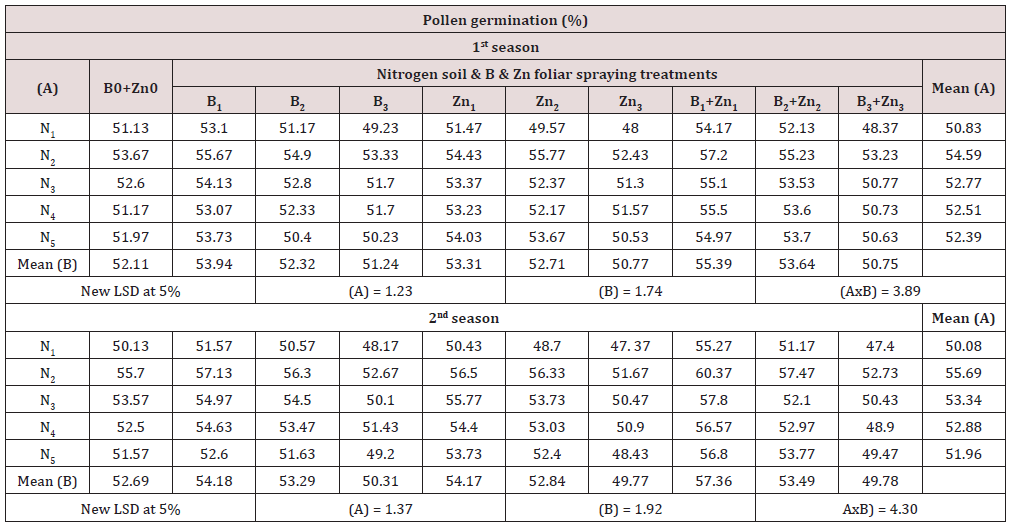
Furthermore, interaction between nitrogen soil application regimes and boron and zinc foliar spraying application during both seasons was significant. Data showed that the combined (N2+B1+Zn1) induced the highest fruit set percentage amounting to (57.2 & 60.37 %) in both seasons respectively. These findings are in agreement with [22] who found that increase in fruit set due to boron might be attributed to its role in maintaining high pollen viability and germination. also, it seems that the improvement in fruit set percentage could be explained as a result of increase pollen tube elongation due to boron treatments [23]. [24] on date palm found that (N, P, K and Zn) spray application can improve fruit set, yield and fruit size without thinning. In addition, zinc is involved in protein synthesis, influence on electron transfer reaction including those in the Kreb’s cycle and subsequently on energy production in the plant and also directly involved in the synthesis of indole acetic acid [11].
Yield (Kg)/tree: It is obvious from data in Table 3 that in both seasons of study on the average yield significantly varied in response to nitrogen soil application regimes. The highest significant yield (106.60 & 107.33 kg) in both seasons respectively was attributed to (N2), while significantly the lowest yield (74.49 & 75.42 kg) was obtained from (N1) treatment as control in both of seasons. On the other hand, yield of avocado varied on the average due to foliar treatments. Supreme crop was attributed to the (B1+Zn1) treatment in both seasons (102.66 & 104.59 kg). Whereas both (Zn3) and (B3+Zn3) resulted in statistically the least crop in both seasons amounting to (87.82 & 89.01 kg) and (82.58 & 84.71 kg) respectively.
Table 3: Effect of nitrogen soil application time, boron and zinc foliar spraying on fruit weight (g) /tree.

Interaction between the studied factors was statistically significant which referred to that nitrogen soil application and boron, zinc foliar spraying act dependently in this concern. The highest yield (113.9 & 116.1 kg) was attributed to from (N2+B1+Zn1) treatment in both seasons respectively, while the lowest yield (69.2 & 64.4 kg) and (68.1 & 65.7 kg) were obtained from (N1+B3+ Zn3) and (Zn3 treated in both seasons, respectively. Enhancements in crop due to the afore mentioned treatments are basically due to their effects on increasing both the pollen grain germination percentage and fruit set percentage .The available reports concerning the effect of nitrogen application time, boron and zinc foliar spraying on avocado yield are in agreement with the results of [14] on avocado and [15] on guava, they found that foliar sprays either boron or zinc increased tree yield.
Physical fruit parameters
Table 4: Effect of nitrogen soil application time, boron and zinc foliar spraying on flesh weight (g)/tree.
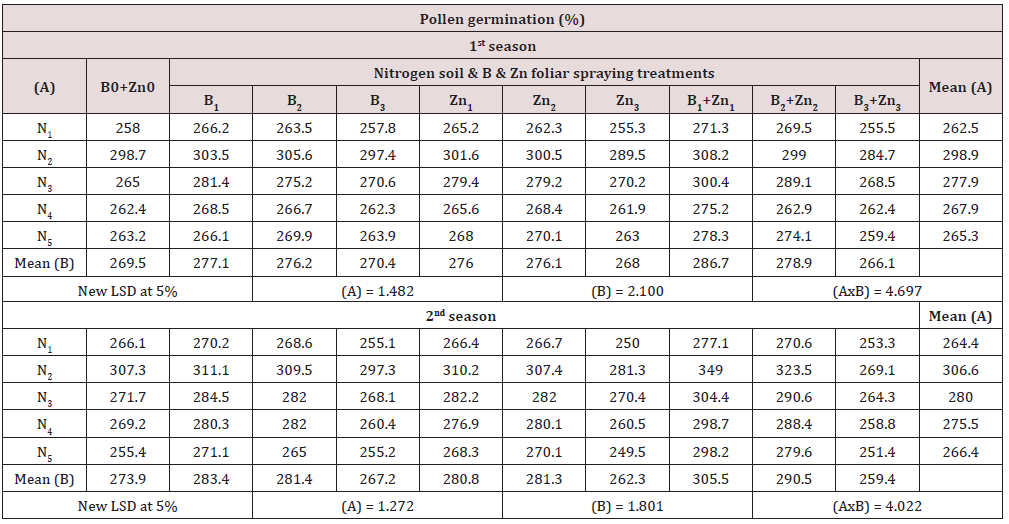
Fruit weight (g): Table 4 indicated that in both of seasons on the average all considered N regimes significantly increased the average fruit weight than control. Highest significant effect was due to (N2) treatment (298.9 & 306.6 g). While, (N1) control showed the lowest values (262.5 & 264.4 g) for both seasons respectively. With regards to boron and zinc foliar spraying treatments on the average, (B1+Zn1) induced the highest significant fruit weight in both seasons (286.7 & 305.5 g) respectively. While both (Zn3) and (B3+Zn3) treatments showed statistically the lowest values (268.0 & 266.1 g) and (262.3 & 259.4 g) respectively. On other hand, interaction between nitrogen soil application and foliar spraying of boron and zinc was significant. Data cleared that fruit weight also attained significantly the highest magnitude due to. (N2+B1+Zn1) treatment resulted (308.2 & 349.0 g) respectively in both tested seasons. Whereas control (N1) in both seasons with (Zn3) and (B3+Zn3) treatments induced the least fruit weight (255.3 & 250.0 g) and (255.5 & 253.3 g). These results are in general concurrence with [25] and [26,27].
Flesh weight (g): Data in Table 5 showed that flesh weight was significantly affected by applied nitrogen regimes on the average. Significantly the heaviest flesh weight was attributed to (N2) treatment (249.0 & 256.7 g). Whereas, control in both seasons and (N5) treatment in the second one showed the lowest flesh weighted. Concerning boron and zinc foliar spraying treatments, on the average significantly the heaviest flesh weight recorded was (244.3 & 264.7 g) was due to (B1+Zn1). Whereas, (B3+Zn3) in both seasons (206.1 & 195.9 g) and (Zn3) (208.5 g) in the first season showed significantly the lowest values. Interaction between the two main factors was significant. The highest magnitude of flesh weight in both of seasons was dedicated to (N2+ B1+Zn1). The obtained results are in line with the finding of (Kumar and Verma 2004) on lichi.
Table 5: Effect of nitrogen soil application time, boron and zinc foliar spraying on flesh weight (g)/tree.
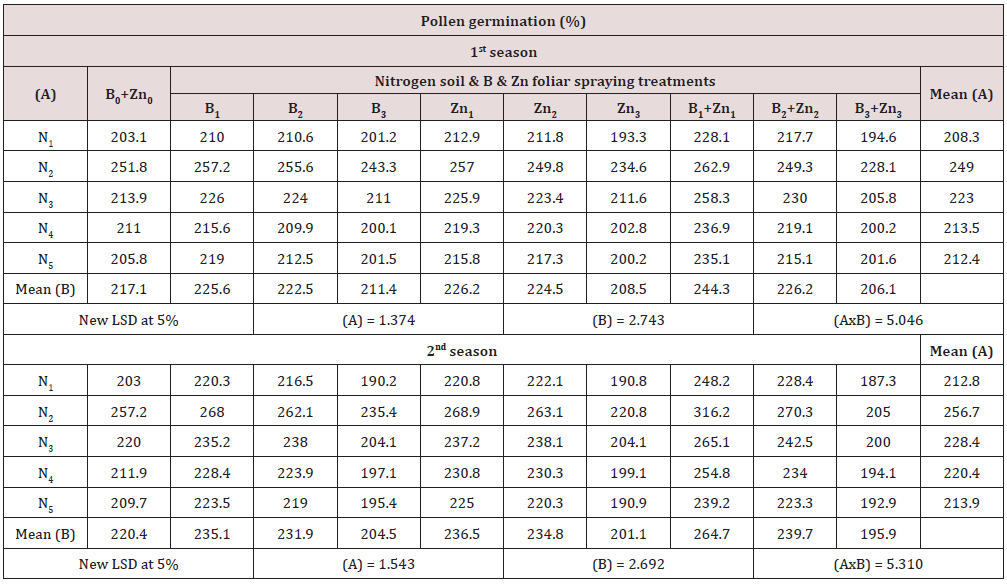
Chemical fruit characters
Oil content (%): Oil content as affected by conducted treatments is presented in Table 6. Data showed that on the average (N2) treatment resulted in the highest significant oil content (15.70 & 15.85 %) for both considered seasons respectively. On the contrary showed (N1) induced significantly the lowest content amounting to (15.05 & 15.08 %) for both seasons respectively with insignificant differences from (N5). As for average effect of foliar treatments, (B1+N1) treatment showed the highest significant oil content amounting to (15.79 & 15.87 %) for both seasons respectively. Whereas, unsprayed trees bore fruits with significantly the lowest oil content (14.96 & 15.04 %) for both considered seasons respectively). Differences from (Zn3) treatment were insignificant. Interaction data were significant. Data showed that highest oil content was attributed to (N2+B1+Zn1) and (N2+ B2+Zn2) treatments with insignificant differences between them. While the lowest content was attributed to N1& no spray treatment in both seasons. These results are in no agreement with those of [15] who illustrated that there was no significant different were observed in fat percentage, however this result in the line with agree with [28] and [29].
Table 6: Effect of nitrogen soil application time, boron and zinc foliar spraying on oil content percentage.
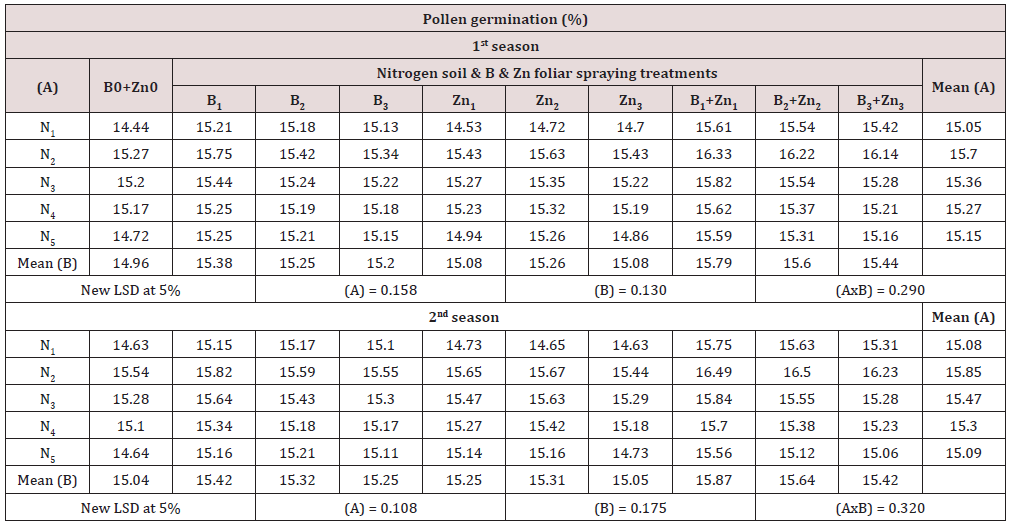
Vitamin C (mg/100g): It’s obvious from Table 7 that (N2) recorded the highest fruit vitamin C content in both of seasons (10.75 & 10.36 mg/100g). Whereas, (N5) treatment showed the lowest magnitudes. As for the average effects of spraying treatment, as (B1+Zn1) was the most effective treatment in this respect in vitamin C with values (10.88 & 10.69 %) respectively compared with the combination of boron and zinc at 3 g/L treatment. The combination of boron and zinc at 1g/L and nitrogen application time treatment (N2) as (N2+B1+Zn1) increased vitamin C fruit content (mg/100g) in both seasons (11.63 & 11.13), while the treatment (N5) with boron and zinc combination in concentration 3g/L as (N5+B3+Zn3) showed the lower values in both seasons with (9.33 and 8.56) respectively. [30] reported that B and Zn sprays enhanced ascorbic acid content in guava.
Table 7: Effect of nitrogen soil application time, boron and zinc foliar spraying on vitamin C (mg/100g).
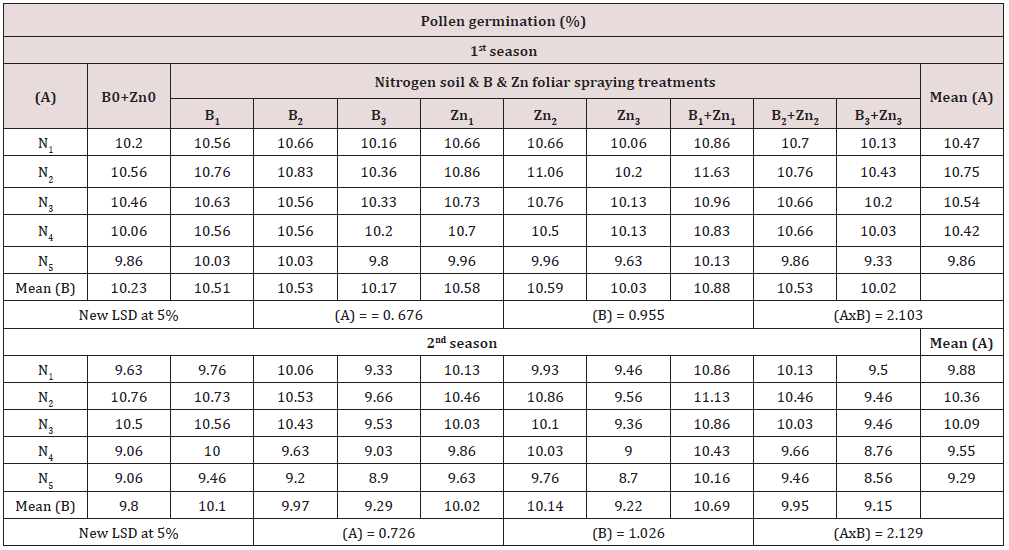
In Conclusion the Present Study Clearly
Illustrate that nitrogen fertilization regimes clearly affect the cropping and its’ attributes in avocados. also, for foliar application of boron and zinc in combination, it showed clear enhancements in terms of increasing pollen grains germination percentage leading to increasing the crop. Also, their application showed enhancements in crop physical and chemical characteristics [31-33].
As a Recommendation
It is preferable to fertilize avocado trees cv. Feurte with nitrogen at 240g/tree during (January), 600g/tree during (May) and 360 g/ tree during (August) combined with 3 foliar application of boron and zinc at 1g/L at for three times, the first at the beginning of flower bud induction in (October), the second spray at bud burst during (January) and the last and third one was at anthesis in (April).
For more Lupine Publishers Publons Click on Below link
https://publons.com/publisher/7295/lupine-publishers-llc

No comments:
Post a Comment